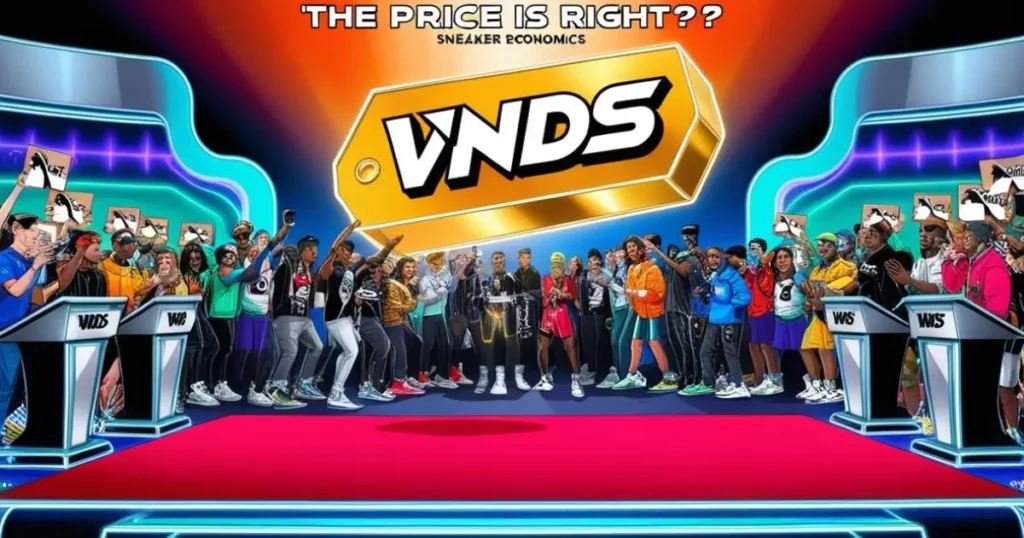In the vibrant world of sneaker culture, where every scuff and crease tells a story, one term has been making waves: VNDS. But what exactly does VNDS mean in shoes, and why has it become such a hot topic among collectors and casual wearers alike? Let’s lace up and dive into the fascinating realm of ‘Very Near Deadstock’ footwear.
Cracking the Code: What Exactly is VNDS?
VNDS, short for “Very Near Deadstock,” is a term that’s become increasingly common in sneaker circles. It describes shoes that are almost new but have been worn or tried on very lightly. To truly understand VNDS, we need to break it down:
- Deadstock (DS): Brand new, unworn shoes with original packaging
- VNDS: Shoes worn once or twice with minimal signs of use
- Used: Shoes with clear signs of wear and tear
VNDS occupies that sweet spot between pristine and pre-loved. Think of it as the “showroom floor model” of the sneaker world – technically used, but you’d barely notice.
Key Characteristics of VNDS Shoes:
- Minimal to no creasing on the upper
- Clean, barely marked outsoles
- Original laces and insoles intact
- No visible wear on the heel or toe areas
- Original packaging often included
VNDS isn’t just about physical condition; it’s a promise of quality and care. It tells potential buyers, “These shoes have been cherished, not abused.”
The Birth of VNDS: From Sneakerhead Slang to Industry Standard
The term VNDS didn’t just appear overnight. It evolved organically within the sneaker community, born out of a need for more nuanced condition descriptions.
Timeline of VNDS Evolution:
| Year | Milestone |
| Early 2000s | Term begins circulating in online forums |
| 2005-2010 | Adoption by major resale platforms |
| 2010-2015 | Widespread use in sneaker marketplaces |
| 2015-Present | Recognition as a standard condition grade |
As online marketplaces for sneakers grew, so did the need for precise language. VNDS filled a crucial gap, allowing sellers to distinguish their gently-used kicks from more worn pairs.
“VNDS gave us a way to describe those shoes that were too good for ‘used’ but not quite ‘new’. It changed the game for resellers and collectors alike.” – Mike, veteran sneaker reseller
The VNDS Spectrum: When “Almost New” Isn’t Quite Enough

Not all VNDS shoes are created equal. There’s a spectrum within the VNDS category itself, ranging from “might as well be new” to “definitely worn, but just barely.”
The VNDS Gradient:
- Pristine VNDS: Indistinguishable from new except for minor outsole markings
- Light VNDS: Minimal creasing, clean throughout, maybe slight discoloration on insoles
- Borderline VNDS: More noticeable wear, but still very clean overall
This spectrum has led to heated debates within the community. Where’s the line between VNDS and simply “lightly used”? It’s subjective, but most agree that any significant flaws or wear patterns disqualify a shoe from VNDS status.
Sherlock Your Sneakers: How to Spot True VNDS Kicks
Identifying genuine VNDS shoes requires a keen eye and attention to detail. Here’s a checklist to help you play sneaker detective:
VNDS Inspection Checklist:
- [ ] Outsoles: Look for minimal dirt or wear patterns
- [ ] Uppers: Check for creasing, especially on leather shoes
- [ ] Insoles: Examine for imprints or discoloration
- [ ] Laces: Should be original and unworn
- [ ] Heel Areas: No visible compression or wear
- [ ] Toe Boxes: Minimal to no creasing or scuffs
- [ ] Overall Shape: Should maintain original form without sagging
Red Flags That Disqualify VNDS Status:
- Significant creasing on the upper
- Visible wear patterns on the outsole
- Frayed laces or damaged eyelets
- Any customization or alterations
- Strong odors or signs of excessive wear
Remember, VNDS doesn’t mean flawless. Minor imperfections are acceptable, but anything beyond light wear crosses the line.
The Price is Right? VNDS and Its Impact on Sneaker Economics

VNDS shoes occupy a unique position in the sneaker market, often commanding prices close to their deadstock counterparts. But what factors influence VNDS pricing, and how do they compare to new and used options?
VNDS Price Analysis:
| Condition | Average Price (% of Retail) |
| Deadstock | 100-150% |
| VNDS | 80-120% |
| Lightly Used | 60-90% |
| Well Worn | 40-70% |
Note: Percentages are approximate and can vary widely based on the specific model and market demand.
Factors that can boost VNDS value:
- Rarity: Limited edition or discontinued models
- Hype: Trendy or celebrity-endorsed sneakers
- Age: Vintage models in exceptional condition
- Original Packaging: Complete with box and accessories
“I’ve seen VNDS shoes sell for more than deadstock pairs, especially for older releases. It’s all about condition and desirability.” – Sarah, sneaker resale platform manager
VNDS in the Wild: Real-world Scenarios and Case Studies
To truly understand the VNDS phenomenon, let’s look at some real-world examples:
Case Study 1: The Vintage Come-Up
Scenario: A collector finds a pair of 1985 Air Jordans in VNDS condition. Outcome: Sold for $20,000, nearly double the price of a deadstock pair from the same year. Lesson: For vintage sneakers, VNDS can be more desirable than unworn pairs, as they prove the shoe’s wearability without sacrificing condition.
Case Study 2: The Hype Beast’s Dilemma
Scenario: A limited-edition collaboration sneaker is worn once and listed as VNDS. Outcome: Sells for 95% of the deadstock price within hours of listing. Lesson: For hyped releases, VNDS offers a sweet spot of availability and value.
Case Study 3: The VNDS Mishap
Scenario: Buyer purchases “VNDS” shoes that arrive with significant wear. Outcome: Dispute filed, refund issued, seller’s reputation damaged. Lesson: Accurate description and documentation of condition are crucial in VNDS transactions.
The Great Debate: VNDS vs. New – Is the Savings Worth It?
Choosing between VNDS and new shoes isn’t always straightforward. Let’s break down the pros and cons:
VNDS Advantages:
- Often significantly cheaper than deadstock
- Opportunity to own rare or sold-out models
- Shoes are already “broken in” slightly
- Environmentally friendly (reduces waste)
VNDS Disadvantages:
- Not truly “new” if that’s important to you
- Potential for hidden flaws or wear
- May lack original packaging or accessories
- Could be harder to resell later
For many sneaker enthusiasts, the minor imperfections of VNDS are a small price to pay for the opportunity to own grail-worthy kicks at a discount.
Keeping it Clean: Maintenance Tips to Preserve VNDS Status
Whether you’re looking to maintain your VNDS finds or keep your new purchases in top condition, proper care is essential.
VNDS Maintenance Tips:
- Clean After Each Wear: Use a soft brush and mild soap to remove dirt.
- Stuff with Paper: Helps maintain shape when not worn.
- Rotate Your Wear: Don’t wear the same pair too frequently.
- Use Protective Sprays: Apply water and stain repellents.
- Store Properly: Keep in a cool, dry place away from direct sunlight.
Material-Specific Care:
- Leather: Condition regularly to prevent cracking
- Suede: Use a suede brush and eraser for stains
- Knit: Be gentle to avoid stretching or snagging
- Canvas: Spot clean and air dry to prevent shrinkage
The Future of VNDS: Trends and Predictions

As the sneaker market evolves, so too will the concept of VNDS. Here are some potential trends to watch:
- AI-Powered Authentication: Technology may soon be able to accurately grade and verify VNDS claims.
- Blockchain Tracking: Each wear could be recorded, creating a transparent history for VNDS shoes.
- Sustainable Focus: As eco-consciousness grows, VNDS may become more desirable as a “green” option.
- Virtual Try-Ons: AR technology could allow buyers to virtually inspect VNDS shoes before purchase.
“I see VNDS becoming more standardized and accepted as the sneaker market matures. It’s not just a trend; it’s a necessary category in our industry.” – Alex, sneaker industry analyst
VNDS Etiquette: Buying, Selling, and Trading with Integrity
The VNDS market thrives on trust and transparency. Here are some best practices to ensure smooth transactions:
For Sellers:
- Provide detailed, honest descriptions
- Include clear, well-lit photos of all angles
- Disclose any flaws, no matter how minor
- Be responsive to buyer questions
For Buyers:
- Ask for additional photos if needed
- Read descriptions carefully
- Check seller ratings and reviews
- Use secure payment methods
Building Trust in VNDS Transactions:
- Use escrow services for high-value sales
- Video the unboxing process
- Leave fair, detailed feedback after transactions
- Participate actively in sneaker communities
Beyond Sneakers: VNDS in Other Fashion Categories
The concept of VNDS isn’t limited to sneakers. It’s spreading to other areas of fashion and collectibles:
VNDS in Other Markets:
- Watches: “New Old Stock” or “Unworn” designations
- Designer Handbags: “Carried Once” or “Like New” categories
- Vintage Clothing: “Deadstock” or “New with Tags” for unworn items
- Electronics: “Open Box” or “Like New” conditions
While the exact terminology may differ, the principle remains the same: items that are essentially new but may have been handled or tried on.
Here are five FAQs with short answers about “What Does VNDS Mean in Shoes?”:
FAQ: What Does VNDS Mean in Shoes?
Q: What does VNDS stand for in the sneaker world?
A: VNDS stands for “Very Near Deadstock,” referring to shoes that are almost new but have been worn or tried on very lightly.
Q: How does VNDS differ from deadstock shoes?
A: Deadstock shoes are completely unworn, while VNDS shoes may have been worn once or twice with minimal signs of use.
Q: Can VNDS shoes have any visible wear?
A: VNDS shoes may have very slight signs of wear, such as minor outsole markings, but shouldn’t have significant creasing or visible wear patterns.
Q: Are VNDS shoes worth less than deadstock?
A: Generally, yes. VNDS shoes are usually priced slightly lower than deadstock, but can still command high prices, especially for rare or vintage models.
Q: How can I tell if a shoe is truly VNDS?
A: Check for minimal creasing, clean outsoles, intact original laces and insoles, and no visible wear on high-friction areas like the heel and toe. Always ask for detailed photos if buying online.
Conclusion: The VNDS Revolution in Sneaker Culture
VNDS has revolutionized the way we think about sneaker condition and value. It’s created a new category that balances desirability with accessibility, allowing more people to participate in sneaker culture without breaking the bank.
As the sneaker market continues to grow and evolve, VNDS will likely play an increasingly important role. It offers a sustainable alternative to constant new purchases and provides a way for rare and coveted shoes to circulate within the community.
Whether you’re a seasoned collector or new to the sneaker game, understanding VNDS is crucial. It’s not just about saving money or finding rare pairs; it’s about participating in a culture that values preservation, appreciation, and the stories behind every shoe.
So next time you come across those VNDS grails, you’ll know exactly what you’re looking at – and why they might just be the perfect addition to your collection.

An author is a creator of written content, producing works ranging from books and articles to blog posts and essays. They use their creativity, knowledge, and research to inform, entertain, or persuade readers. Authors often have a unique voice and perspective, contributing significantly to literature and various media.

